Changing the engine oil in your car is a necessary maintenance procedure that prolongs the motor’s life. Unfortunately, driving a vehicle overfilled with engine oil will reduce its life drastically. But realistically, how much overfill will cause a problem, and how long can I run my car with too much oil?
Driving for about 1,600 kilometers/1,000 or a week (whichever comes first) without causing any damage is possible; however, this depends on the amount of overfilled oil. I must clarify that the driving time/distance depends on the amount of overfill. You will find more detailed information on this and the potential problems driving with too much oil in this article below; I encourage you to read it before taking any unnecessary risks.
How Long Can I Run My Car With Too Much Oil?
As I’ve already mentioned, driving for a week or 1600 kilometers/ 1,000 miles is possible, but this depends on the amount of overfilled oil. There are also instances where you do not need to worry because the amount of overfill is insignificant, and you can continue driving worry-free forever. To put all this into context, the table below explains the quantity of overfill and the mileage you can expect to drive before it will potentially cause problems.
| Measurement | Distance |
| 0 – 0.1 quart or 0 – 100ml | Drive as normal |
| 0.1 – 0.2 quart or 100 – 200ml | Drive as normal, remove excess if possible |
| 0.2 – 0.5 quart or 200 – 500ml | 1,600 km or 1,000 miles |
| 0.5 – 1 quart or 500ml – 1L | 1,600km or 1,000 miles |
| 1 quart + or 1L + | Do not drive drain excess oil |
Before you think excellent, I’ve got time before this needs sorting. Please note that these distance indications are well-educated guesses that have taken many years of knowledge working on various vehicles. The problem is every vehicle is slightly different and each will react differently to the amount of overfilled oil, so there no guarantees.
The exact length of time depends on factors that you, as the driver or even the best mechanics in the world, cannot tell you—for example, the engine’s condition before it was overfilled with oil. You might exceed the mileage recommendation without any problems in one motor because the internals are strong, like new. But, in another engine, the seals weren’t in great condition, so it lasted half the miles before the engine blew up. Driving with an engine overfilled with oil is a risk; you decide to take that risk, and it might not play out how you want it to.
How to Tell How Much Extra Oil Is in the Engine?
While the oil is still in the engine, deciding how many quartz or milliliters the engine is overfilled by is difficult. But you can make a good guess using a ruler measuring against the dipstick.
Most car engine dipsticks’ minimum and maximum marker is approximately 1 liter or 1 quart. So if you take a ruler and measure between the minimum and maximum marker on a dipstick, divide by ten equals measurements, each of these ten measurements equals 100ml or 0.09 quarts. If you then measure the overfill from the maximum marker, you can determine how much extra oil you have. This isn’t 100% perfect, but it’s as good as it will get without removing the oil and measuring it.
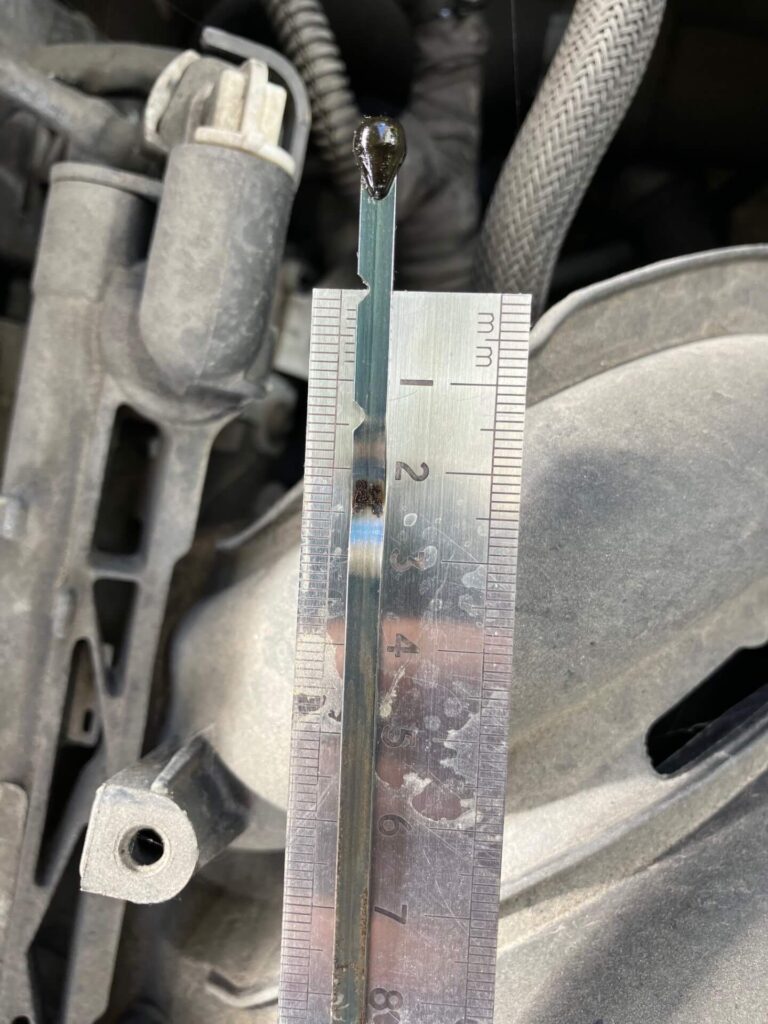
What Happens if You Drive With Too Much Oil?
A vehicle engine is a perfectly balanced machine built with many moving parts requiring a specific amount of lubrication. Engine oil is that lubricant. When an engine is off, the oil sits in an oil pan at the bottom. When you turn the ignition on, the oil gets pumped around the motor, passing through an oil filter to remove any harmful contaminants and debris that could cause damage.
When you have too much engine oil, the crankshaft rotates in the excess oil at the bottom of the engine (It’s not normally in direct contact with a large amount of oil if filled to the correct level), churning and aerating the oil. Aerated oil becomes a thick, foamy solution with a consistency similar to treacle, much thicker than the oil was previously. The oil pump then forces the aerated oil through oilways in the engine, which can cause a blockage and a rise in oil and engine pressure. This also means it is ineffective at lubricating engine components, which will cause them to dry out and destroy themselves.
This extra pressure has no choice but to force the oil out of the engine by blowing gaskets and seals, causing further problems such as overheating and performance loss. It’s an expensive fix as the engine may need a complete overhaul, requiring it to be removed and stripped to repair. This is the worst-case scenario and won’t happen if you are just a fraction over the maximum marker; the car will burn away a small amount of oil as you drive, so do not panic.
One last thing to note when you have too much oil is once the oil is forced through the gasket and seals into the combustion chamber; the motor will burn the oil, so you can expect a strong burning smell.
When to Not Drive With Extra Oil in the Engine
If you notice any of the below with an engine overfilled with oil, do not drive or pull over if you’re already driving:
- Suspicious noises from the engine
- Warning lights on the dashboard
- Rising engine temperatures
- Smoke coming from the oil cap
- An excessive amount of smoke coming from the exhaust
- Reduced engine performance
- Foam on the dipstick when checking the oil level
Any of the above could indicate that you have a severe problem; continuing driving will cause a lot more damage, and the repair could get much more significant. Then again, you may have caught a bigger issue just in time, but it will still require recovering the vehicle home, removing the excess oil, and seeing what happens.
How to Remove Excess Engine Oil
You can remove a small amount of oil by removing the sump drain plug at the bottom of the engine. Make sure you have an oil drain pan to catch the oil. Once some has drained, reinsert the drain plug quickly. This is a messy method, and oil will spray everywhere when you’re trying to reinsert the sump plug while the oil is still trying to pour from it. I don’t recommend doing this on the driveway at home without using a ramp and oil drainer. Instead, use an extractor or siphon in the dipstick tube.
Using a fluid extractor is the easiest way to remove a minimal amount of oil without making a mess, and it can be done in a couple of minutes. First, you’ll need a suitable fluid extractor to remove the oil.
A hand pump extractor will come in handy for draining excessive engine oil or other overfilled fluids, coolant, brake fluid, etc., without completely removing all the oil or fluid. The added benefit of using a hand pump siphon is you control how much oil gets extracted.
To remove excess engine oil, the siphon tube can be inserted directly into the dipstick tube; this goes into the engine oil pan. Push in until it reaches the oil or the bottom of the sump. You can then pump the extractor handle to remove the oil. Once you are satisfied you’ve removed a reasonable amount, re-check the oil level. Repeat until at the maximum level on the dipstick.
If you are not confident doing this yourself, take your vehicle to the garage to have a mechanic fix the overfill issue. However, they may replace the oil and filter again to avoid further problems, which is a good thing regardless of when it was last changed.
Remember, regardless of how you remove the excess oil, please correctly dispose of engine oil at your local waste disposal facility. Engine oil harms the environment, so it cannot be disposed of at home by pouring it down the drain!
Frequently Asked Questions
Will The Oil Light Come On If There Is Too Much Oil?
The oil light will rarely come on if the engine oil is overfilled. However, if your car has an oil pressure light(not every vehicle has one), the oil pressure will rise when overfilled, triggering the oil pressure light to come on.
Will Excess Oil Burn Off?
A small amount of excess engine oil will burn off as the car is driven. Some vehicles, like diesel-fuelled cars, burn more engine oil than gasoline engines. Excessive oil burning can be a sign of another issue like old engine oil and should be inspected by a mechanic if your car is burning through a lot of oil.
Can Too Much Oil Stop A Car From Starting?
An overfill of significant engine oil can stop the car from starting. When excess oil is forced into the engine cylinder, the oil fouls the spark plugs, meaning the plug’s tip becomes coated in oil. Fouled spark plugs can no longer provide a spark to ignite the fuel due to the contamination, meaning the car will struggle to start.
Can Too Much Oil Damage Your Engine?
Yes, running a car with too much oil, either severely overfilled or overfilled, and continuously driving can cause damage to the engine. The pressure inside the engine will rise to dangerous levels, putting extra stress on seals and gaskets. When a seal or gasket fails, the oil will find its way into areas of the motor it shouldn’t be causing irreversible damage.
Final Words
Overfilling an engine with excess oil can be done accidentally. It can be a costly mistake if it is not put right immediately. But to answer, how long can you drive your car with too much oil? The answer is for about a week or 1,600 kilometer/1,000 miles if overfilled by a small amount; refer to the table in this article for the exact amounts and distances. If you ignore this advice, a short emergency journey should be the only distance considered if severely overfilled. Instead of taking any risks driving with an engine overfilled with oil use an extractor to remove the excess oil; its simple to do. You can then continue driving in peace without the thoughts of the car failing at any moment hanging over you!



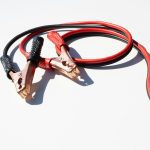
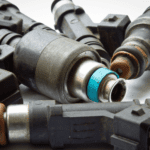
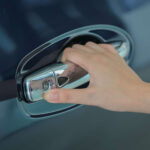


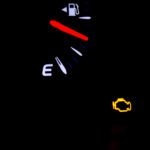
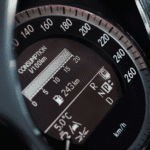
Hi,
I think I might have overfilled the oil in my car’s engine (Honda CR-V 2004) back in july. I think it may have been about 300 ml, about half a centimeter above the mark. We went on a big trip right after and since then drove for four months with no problems, over 2000km altogether. A few days ago the engine warning sign lit up (orange, not red, not flashing). The engine seems to be working properly, for now. Can it be related to the overfill? Thanks in advance for your answer. I’ve been banging my head on the wall since i realized this, so I would really like to know a professional opinion before I manage to get it checked.
Thank you for your comment. I think this will be coincidental that you overfilled the engine oil and now have the warning indicator illuminated. As you indicated it is the engine light and not the oil light, it will probably be something else. It may be the result of overfilled oil but as you say it’s only around 300ml I find this very unlikely. You may already know this but in order to understand what the reason for the light illuminating is, you will need to have the car plugged into a diagnostic machine, most good mechanics will have one.
Good luck!
Carsneedcare.com
Hey, my hilux bakkie is likely overfilled with Engine oil and have have troubles starting it. What can I do ?
Thanks for your question. First I would address the overfilled oil issue and see if that makes a difference. It would have to be a severe amount of overfill for it to struggle starting. If you get the oil to the right level in between the dipstick markers and leave the car running (if it will) it may burn away any excess oil causing the issue. Sorry to be a little vague with the help but the cause of the starting issue may not be the oil at all. I would also have a read of this article.
Let us know how you get on.
carsneedcare.com
Hi I recently had a bad mechanic put too much oil in my car. I drive it about 15 miles and noticed the exhaust was smoking. I have it parked at my house now and haven’t moved it since. Would draining it entirely and filling it to the right amount of oil help any??
Hi,
Thanks for your message. It depends on where the smoke is coming from; it’s not normal for a bit of spillage when the oil filter is changed, which needs to burn away. Depending on the oil filter location, it could have spilled on the exhaust.
But if it’s coming out of the tailpipe, I suggest draining the excess oil until it’s at the correct level, then letting the car run idle for about 15-20 minutes. If the smoke clears, go for a little drive and keep an eye on the amount of smoke coming out the exhaust; if it continues to be big clouds of white/blue smoke, then there’s probably a gasket or oil seal faulty within the motor. But, if it returns to normal, then carry on and recheck the oil level every week for a month or two.
Regards
Tommy
carsneedcare.com